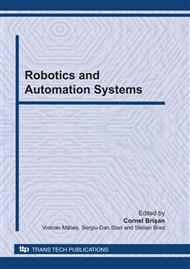[1]
Hairer, E., Wanner, G.: Solving Ordinary Differential Equations II: Stiff and DifferentialAlgebraic Problems, Springer Series in Computational Mathematics, Springer, Berlin; 2nd edition, 2nd printing, (1996).
DOI: 10.1007/978-3-642-05221-7_1
Google Scholar
[2]
Ascher, U. M., Petzold, L. R.: Computer Methods for Ordinary Differential Equations and Differential Algebraic Equations, Society for Industrial Mathematics, illustrated edition, (1998).
DOI: 10.1137/1.9781611971392
Google Scholar
[3]
Fritzson, P.: CPrinciples of Object-Oriented Modeling and Simulation with Modelica 2. 1, John Wiley & Sons; 1st Edition, (2004).
Google Scholar
[4]
Verein Deutscher Ingenieure (VDI): Entwicklungsmethodik für mechatronische Systeme, VDIRichtlinie 2206, Beuth Verlag, Berlin, 2004 (English title: VDI guideline 2206: Design methodology for mechatronic systems).
Google Scholar
[5]
Schlemmer, M.: Eine SQP-Rückwärtskinematik zur interaktiven, semi-autonomen Bahnführung kinematisch redundanter Manipulatoren, Fortschritt-Berichte VDI, Reihe 8, Nr. 825, (2000).
Google Scholar
[6]
Lalo, W., Brandt, T., Schramm, D. and Hiller, M.: A linear optimization approach to inverse kinematics of redundant robots with respect to manipulability, 25th International Symposium on Automation and Robotics in Construction, (2008).
DOI: 10.3846/isarc.20080626.175
Google Scholar
[7]
Komainda, A.: Methoden und Verfahren zur Online-Bahnplanung redundanter Schwerlastmanipulatoren, Fortschritt-Berichte VDI, Reihe 8, Nr. 993. (2003).
Google Scholar
[8]
Khatib, O: Real-time obstacle avoidance for manipulators and mobile robots, The International Journal of Robotics Research, vol. 5: pp.90-98. (1986).
DOI: 10.1177/027836498600500106
Google Scholar
[9]
http: /www. mercatronics. de.
Google Scholar
[10]
Schneider, M.: Modellbildung, Simulation und nichtlineare Regelung elastischer, hydraulisch angetriebener Großmanipulatoren, Fortschritt-Berichte VDI, Reihe 8, Nr. 756, (1999).
Google Scholar
[11]
Hiller, M., Kecskeméthy, A. and Woernle, C.: A loop-based kinematical analysis of spatial mechanisms, ASME-Paper 86-DET-184, New York.
Google Scholar
[12]
Christen, F.: Funktionsentwicklung von Fahrerassistenzsystemen mittels Fahrsimulator, 4. TecDay, Aschaffenburg, (2008).
Google Scholar
[13]
Reymond, G. and Kemeny, A.: Motion Cueing in the Renault Driving Simulator, Vehicle System Dynamics, 34, pp.249-259, (2000).
DOI: 10.1076/vesd.34.4.249.2059
Google Scholar
[14]
Locher, J. and Kleinkes, M.: Ein Simulator zur Bewertung und Optimierung von Fahrerassistenzsystemen, VDI-Berichte, ISSN 0083-5560, Der Fahrer im 21. Jahrhundert, Braunschweig, (2003).
Google Scholar
[15]
Hiesgen, G., Unterreiner, M., Hesse, B., Brandt, T., Schramm, D.: A Tool for the Early Integration of the Driver into the Development Process of Driver Assistance Systems, Manuscript VDI Integrierte Sicherheit und Fahrerassistenzsysteme, (2008).
Google Scholar
[16]
Mitschke, M. and Wallentowitz, H.: Dynamik der Kraftfahrzeuge, 4th Edition, Springer Verlag, (2004).
DOI: 10.1007/978-3-662-06802-1
Google Scholar
[17]
Schramm, D., Hiller M., Bardini R.: Modellbildung und Simulation der Dynamik von Kraftfahrzeugen, Springer, Berlin; 1st Edition, (2010).
DOI: 10.1007/978-3-540-89315-8
Google Scholar
[18]
Schnelle, K. P.: Simulationsmodelle für die Fahrdynamik von Personenwagen unter Berücksichtigung der nichtlinearen Fahrwerkskinematik, VDI Fortschritts-Berichte, Reihe 12, Nr. 146, VDI Verlag GmbH, Düsseldorf, (1990).
Google Scholar
[19]
Müller, T. and Rohleder, D.: Automatisches Spurfahren auf Autobahnen, In: FahrdynamikRegelung, Editor: Rolf Isermann, pp.285-306, Vieweg Verlag, (2006).
DOI: 10.1007/978-3-8348-9049-8_13
Google Scholar
[20]
Switkes, J. P.; Rossetter, E. J.; Coe, I. A. and Gerdes, J. C.: Handwheel Force Feedback for Lane Keeping Assistance: Combined Dynamics and Stability, 7th International Symposium on Advanced Vehicle Control AVEC'04, Arnhem, Netherlands, (2004).
DOI: 10.1115/1.2229256
Google Scholar


